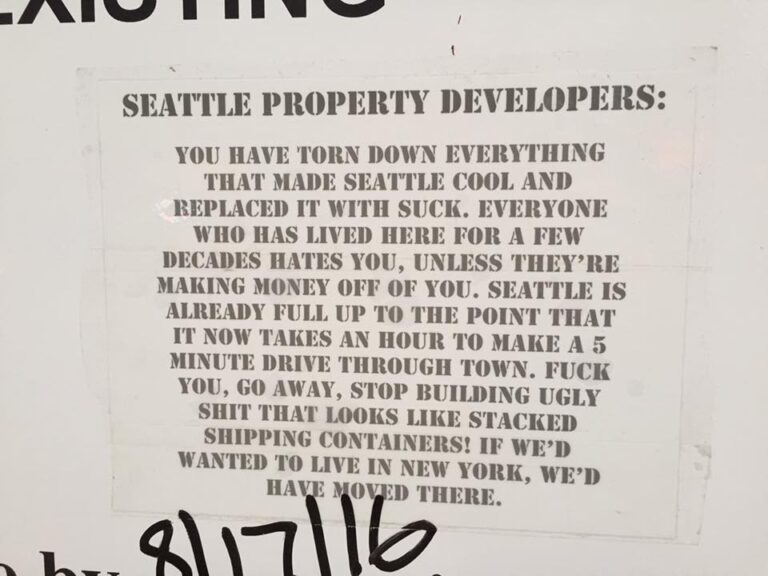Physical Address
304 North Cardinal St.
Dorchester Center, MA 02124
Physical Address
304 North Cardinal St.
Dorchester Center, MA 02124

1. This week at Market Urbanism: The “Global Buyers” Argument by Michael Lewyn The argument makes sense only when you add the following premise: housing prices can only be high in the presence of huge numbers of rich foreigners. I really don’t see any reason to take this premise seriously. Home-Sharing and Housing Supply by Michael Lewyn And if turning long-term rentals into short-term rentals is socially harmful, isn’t it even more harmful to prevent those long-term rentals from being built in the first place? Yet government does exactly that through zoning codes- often at the behest of neighborhood homeowners. Visions of Progress: Henry George vs. Jane Jacobs by Sandy Ikeda Much has been written, pro and con, on George’s single tax and also on Jacobs’s battles with planners the likes of Robert Moses, and if you’re interested in those issues you can start with the links provided in this article. Here I would like to contrast their views on the nature of economic progress and the significance of cities in that progress. Urban[ism] Legend: A Home Is A Good Investment by Emily Hamilton pursuing policies that encourage homeownership at the expense of other investment vehicles leaves people of all income levels worse off. Often, home ownership simply leads to higher levels of housing consumption rather than wealth-building. The consequences of buying a home may be dire for low-income families, and for the middle-class the decision should be based on rational calculations rather than the homeownership cheerleading that both parties offer. Airbnb Crowding Out Is A Symptom, Not A Cause Of Housing Shortages by Jim Pagels That Airbnbs may in fact take some small portion** of houses from the optionally relatively fixed full-time housing stock is a symptom, not a cause, of housing shortages and high prices. Asking if […]
1. This week at Market Urbanism Shut Out: How Land-Use Regulations Hurt the Poor by Sandy Ikeda My colleague Emily Washington and I are reviewing the literature on how land-use regulations disproportionately raise the cost of real estate for the poor. I’d like to share a few of our findings with you. Are States Really The Solution To Urban Mismanagement? by Matt Robare Cities would finally have to confront their land use and economic development policies, employee compensation and infrastructure management; while states would have to confront their redistribution of revenue to rural areas. While state emergency managers and receivers have turned financially struggling cities around, it’s not hard to think that they might be needed less if cities were free. Market Urbanism Podcast Episode 02: Emily Hamilton on Land-Use Regulation and the Cost of Housing by Nolan Gray The question I am left pondering: how can we convince homeowners—who have a large vested interest in the current system—to support land-use liberalization? Feel free to share your thoughts on this and other topics in today’s episode in the comment section below or with Emily and I on Twitter. Supply and Demand: A Response to 48hills by Jeff Fong No matter what example we look at or how we cut up the data, there’s nothing out there to contradict the basic YIMBY story about supply, demand, and price. Unless, of course, you don’t actually understand the story, which may be the problem in Ms. Bronstein’s case. 2. Where’s Scott? Scott Beyer left Texas this week for Phoenix, stop #8 on his 30-city writing tour. He has settled in the neighboring suburb of Tempe, which is home to Arizona State University and is perhaps the metro’s most intensive urban area. Scott also started a Twitter account this week, and will post […]

1. This week at Market Urbanism Palo Alto: The Land of Too Many Jobs by Jeff Fong The status quo isn’t defensible if you’re concerned with environmental degradation, inequality, poverty, slow growth, or even the decline of property rights. But, for tax protected homeowners, the status quo is exactly what they want and that’s reason enough for them to defend it. If Mayor Burt had simply called it like it is—that those in control of Palo Alto land use like the status quo, aren’t concerned with how it affects others, and will continue blocking incremental change—then we could have at least applauded his honesty. When It Comes to Walkability, Mexico City Is Miles Ahead by Nolan Gray Where in many U.S. cities open space is regulated into every single lot through floor area ratio regulations, Mexico City’s developments are dense and public space is efficiently relegated to the city’s ample parks and public spaces. This density and mixture of uses keeps sidewalks busy and safe at nearly all hours of the day. The Answer to Expensive Housing: Build More by Sanford Ikeda If you restrict the supply of housing, other things equal, what will happen to the price? That’s not a trick question. Any competent Econ 101 student would answer correctly that the price will rise. Can Housing Quotas Affect Demand For Housing? by Chris Bradford It’s a provocative argument. It turns the Econ 101 arguments upside down. Not surprisingly, it generated a fair amount of annoyed twitter chatter from market urbanists (including me) and sage head-nodding from those who believe new construction begets high home prices. 2. Where’s Scott? Scott Beyer is halfway through the longest single drive of his trip, the 1,000 miles between Austin and Phoenix. He will be stopping in San Antonio, Del Rio, El […]

1. This week at Market Urbanism Episode 1 of the Market Urbanism podcast came out this week. Nolan Gray plans to release new episodes bi-weekly. The RSS feed is http://feeds.soundcloud.com/users/soundcloud:users:236686274/sounds.rss You can currently find the podcast on Soundcloud and PlayerFM. It will be available within the next few days on iTunes, Stitcher, and TuneIn. If there are other podcasting services you would like me to plug the RSS feed into, please let me know in the comment section below. Cities And The Growth Of Our Collective Brain by Emily Hamilton Sandy Ikeda describes the entrepreneur’s environment as the “action space.” Today, an action space could be in a suburban home for an entrepreneur who creates a digital product that’s sold online. While action space doesn’t necessarily need to be a place of high density, this face-to-face element remains a key part of the world’s most productive action spaces. Economist Sandy Ikeda, a previous MU contributor, is back. Here’s the first of what will be weekly content, published every Tuesday at 10am eastern standard time–How The Housing Market Works In other words, it’s not the entrepreneurs, developers, architects, and construction companies that build very expensive housing in cities like New York that drives up housing prices! Indeed, those people are responding to what they believe buyers are willing to pay, and if they are prevented from building those units the result will be higher prices for everybody. And if you observe housing prices rise despite increasing supply, that probably indicates demand is currently increasing faster than supply. Prices, however, would have been even higher were the government to undertake policies that restricted supply. 2. Where’s Scott? Scott Beyer is spending his last night tomorrow in Austin. Then he’ll spend a couple days in San Antonio, before leaving Texas. His Forbes article this week […]

1. This week at Market Urbanism Buses and Trains: The Turtle and the Hare? by Asher Meyers With buses a relatively safe, cheap and green form of travel, the wisdom of the government favoring trains at great public expense is dubious. This isn’t to say that trains are bad and buses are good—to each his own. But given the trade-offs involved, buses cannot be dismissed as inferior and obsolete—in the real world, budgets are limited and prices matter, so a small sacrifice of time and comfort is worth the savings. Parking Requirements Increase Traffic And Rents. Let’s Abolish Them. by Brent Gaisford Let’s get rid of parking minimums and allow new apartments to be built either without parking, or the reduced amount of parking preferred by developers. People without parking are less likely to drive, and less driving means less traffic. Plus, we’ll be one step closer to reducing our stratospheric rents. 2. Where’s Scott? Scott Beyer is in Austin. His two Forbes articles this week were about how Washington, DC’s Zoning Regulations Target ‘Fast Casual’ Restaurants and Tokyo’s Affordable Housing Strategy: Build, Build, Build The city had 142,417 housing starts in 2014, which was “more than the 83,657 housing permits issued in the state of California (population 38.7m), or the 137,010 houses started in the entire country of England (population 54.3m).” Compare this with the roughly 20,000 new residential units approved annually in New York City, the 23,500 units started in Los Angeles County, and the measly 5,000 homes constructed in 2015 throughout the entire Bay Area. Scott’s previous article on Austin’s rail transit, already well-cited by local media, got additional coverage in the American Spectator. 3. At the Market Urbanism Facebook Group: Adam Hengels on Stark Truth Radio with Robert Stark Ahmed Shaker posted videos of pedestrian and street traffic in […]

1. This week at Market Urbanism Does Home-sharing Create Negative Externalities? by Michael Lewyn Homeowners’ fear of being overrun by “transient” renters is based on an outmoded picture of urban life. In a rural area where most people are born and die in the same town, a fear of “transients” may make sense- but urban life is already highly transient. In renter-dominated blocks, people move in and out every year, so transience is already the norm. 2. Where’s Scott? Scott Beyer has, starting tomorrow, one week left in Austin. Tomorrow he’s visiting the southwestern Texas town of San Angelo. His two Forbes articles were about a Houston builder constructing the nation’s largest micro-unit project and Why Austin Needs to Unleash Sixth Street These noise complaints follow the same rationale as complaints now routinely made about new housing, offices or retail. That is, people move into urban areas thinking they will enjoy the benefits of greater density and culture; but when those qualities prove inconvenient, they try to squelch them. Scott’s work was also splashed all over Austin’s local news this week. He did two TV appearances–to discuss the city’s rail transit line and safety on sixth street–and was cited about these issues in the Austin American-Statesman, the Austin Business Journal, Curbed Austin and Austin.com (among other publications). 3. At the Market Urbanism Facebook Group: Ahmed Shaker reports his experiences of Chuadanga, Bangladesh and finds it dense, bustling, full of mixed-uses, and private transportation options are plentiful. Shanu Athiparambath wrote Why Do People Love Their Cities But Hate Urban Living? Todd Litman wrote: Funding Multi-Modalism at Planetizen via Rocco Fama and Christopher Robotham: Donald Shoup and Aaron Renn on the City Journal podcast via Mark Frazier: Does Elon Musk Understand Urban Geometry? via Matt Robare: City taxes as urban growth policies: choosing the taxes that get you […]

1. This week at Market Urbanism Does President Obama Have A ‘Regionalism’ Agenda? by Scott Beyer Such policies represent less a turn towards socialism, than one away from the nation’s existing socialized paradigm favoring suburbs, wherein housing regulations restrict dense infill development, while the public foots the costs of state highways, local roads, and other sprawl infrastructure. Obama, for all of his supposedly urban bias, has not been immune to extending this paradigm; for example, his stimulus package, writes economist Ed Glaeser, disproportionately benefited low-density states with low unemployment. 100 Years After Zoning In New York City, Government Dominates Land Use by Vince Graham Zoning is segregation – not only of land uses deemed incompatible, but of people deemed “undesirable.” Progressives behind New York City’s 1916 zoning ordinance regarded immigrants moving into northern cities from Europe and the South as “undesirable.” NIMBYs Outdo YIMBYs In Organizing Ability by Krishan Madan The reason boils down to the classic problem of concentrated costs and dispersed benefits: the beneficiaries of new housing are scattered, while those who benefit from a housing shortage–and thus higher prices–are concentrated. These organizational skills enable NIMBYs to dominate the discussion. 2. Where’s Scott? Scott Beyer spent his 3rd week in Austin. His two Forbes articles were Dallas And Houston: Centers For Economic Development and Austin’s Commuter Rail Is A Monument To Government Waste In 2014, the rail line had an operating deficit of $12.6 million. The upfront capital costs of $140 million, when amortized at 2% over 30 years, creates an additional $6.2 million annual cost to taxpayers. Add these two sums up, and then divide them by the line’s number of annual unlinked trips—763,551—and the per-trip subsidy works out to $24.62. 3. At the Market Urbanism Facebook Group: A Market Urbanism podcast with Nolan Gray? Yes, it’s coming, and some hints leak […]

1. This week at Market Urbanism Quantifying the effects of California zoning rules by Emily Hamilton Kip Jackson finds that California zoning rules and other land-use restrictions not only reduce the growth rate of new housing stock, but a new regulation can actually be expected to reduce the existing stock of housing by 0.2% per year. This correlation is greatest when looking only at multifamily buildings, where each new restriction results in 6% fewer apartments built annually. Tech for Housing: An Experiment in YIMBY Activism by Jeff Fong We want to make participation in land use reform a conspicuously consumable good within Bay Area tech. We want everyone within tech to identify as YIMBY by default and for that reflexive self-identification to tip the scales of everyone’s internal cost benefit analysis in favor of having an articulable opinion and taking minimal actions like sending a letter, signing a petition, or casting a vote. 2. At the Market Urbanism Facebook Group: Shanu Athiparambath wrote, Elevators are a Mass Transit System Adam Millsap wrote, Recessions Don’t Have The Same Impact On Every City Shanu Athiparambath wrote, Zoning Is Unjust, Anti-Poor & A Cause of Inequality via Tobias Cassandra Holbrook: Cash-Strapped Towns Are Un-Paving Roads They Can’t Afford to Fix via Vinay Natu, “Man behind charter cities – Paul Romer, named for Chief Economist, World Bank“ via Melanie Meharchand, “The Coastal Commission wrote a letter chiding the City of Laguna Beach for its overly-restrictive regulations on short-term rentals.” via Nolan Gray, “Hard to tell who’s more irritating here, the weirdo utopian schemers or the petty narrow-minded NIMBYs:” A Mormon Tycoon Wants to Build Joseph Smith’s Mega-Utopia in Vermont via Roger Valdez: Renting in Seattle? City could put a cap on your move-in fees via Matt Robare: The Tyranny of Free Parking via Jake Thomas: Housing […]
1. This week at Market Urbanism Nick Zaiac contributed his first Market Urbanism piece: The Cato Institute Goes After Arbitrary Historic Preservation Laws between municipalities they can vary, depending on the precedents set by different circuit courts. Now the Cato Institute, a libertarian Washington think tank, is filing a brief that aims to bring consistency to these laws nationwide. Your Town Is A Financial Timebomb by Johnny Sanphilippo: Do your best Ross Perot imitation and say the words, “sucking sound.” The primary difference between the older development pattern and the stuff that’s being built today has to do with the ratio of public investment vs. private value. Downtown and the adjacent residential areas are mostly small-scale, compact, multi-story buildings with a minimum amount of roads, pipes, and wires connecting them. The new stuff is overwhelmingly huge roads, attenuated water and sewer lines, endless cables and a tremendous amount of surface parking and grass. 2. Where’s Scott? Scott Beyer spent his first week in Austin, and this weekend will visit the city’s northern suburbs, including Cedar Park, Round Rock and Georgetown. His Forbes article this week was about how Miami’s Parking Deregulation Will Reduce Housing Costs While Frey was unsure yet about what kind of rents the building would command, he estimated that building structured parking–in this case 12 spaces, under the previous regulations–would have cost $300,000, or $25,000 per space. This, he said, would have added roughly $330 per month to average rents 3. At the Market Urbanism Facebook Group: Sandy Ikeda spoke about Jane Jacob’s legacy at the Museum of Eldridge Street alongside Mindy Fullilove and Ron Schiffman. Sandy asked the MU group for some clarification on statements made at the event by Ron Schiffman, an urban affairs scholar at the Pratt Institute. After some interesting dialogue, Sandy concludes Schiffman likely misused terms. David […]

1. This week at Market Urbanism, we’re Liberalizing Cities From The Bottom Up Middle Aged NIMBYs, Young YIMBYs by Michael Lewyn Most of the Pro-Urb posters on housing costs assume that high rents are the result of insatiable demand driven by wealthy foreigners, that government lets developers do as they please, and that housing supply is pretty much irrelevant. Why The Tech Industry Should Care About Housing by Jeff Fong Our broken housing system is silently depriving us of future contributors who could build great things; and for each individual who’s preemptively priced out, we’ll never know what those things might have been. Is Commercialism Making Cities Less Livable? by Shanu Athiparambath Are these people correct? If they were, the world’s most commercial cities would be the least livable. But anyone with a modicum of education or travel experience knows this is not true. The cities with the most economic freedom, commercial enterprise and prosperity–think Hong Kong, Singapore, London, Sydney and Vancouver–also have the highest living standards. 2. Where’s Scott? Scott Beyer will spend his last day in Dallas tomorrow visiting the downtown location of the recent sniper attacks. The rest of his weekend will be in Fort Worth, and the rest of July in Austin, stop #7 on his 30-city writing tour. 3. At the Market Urbanism Facebook Group: Brent Gaisford wants to get together with fellow Los Angelenos “if you want to get more involved in the fight for affordable, urbanist housing in LA“ Sandy Ikeda is surprised by an update on China‘s largest “ghost city” Cato Institute filed a brief urging the Supreme Court to take up a case that would restrict historical districting via takings law. Nick Zaiac and Randal John Meyer were involved in the research Shanu Athiparambath wrote Why Building In India Is A Challenge and These Income Segments […]